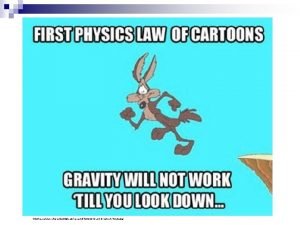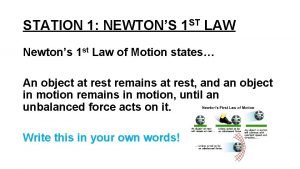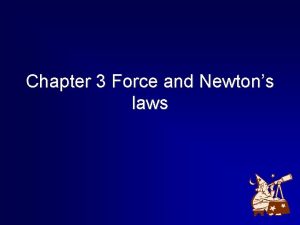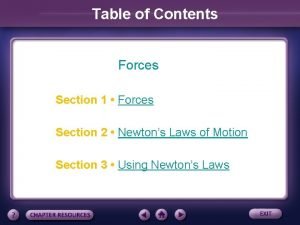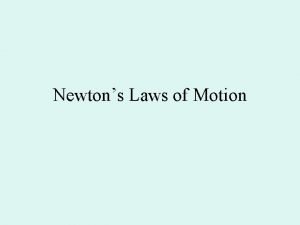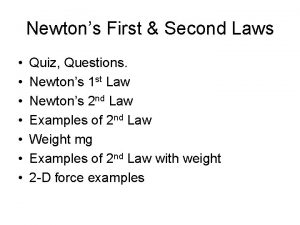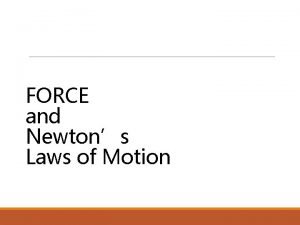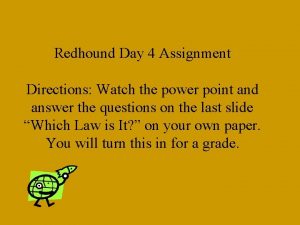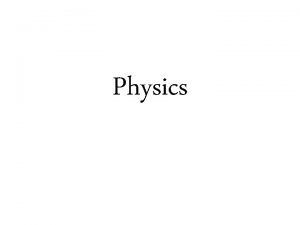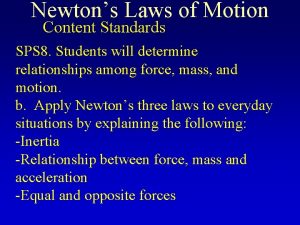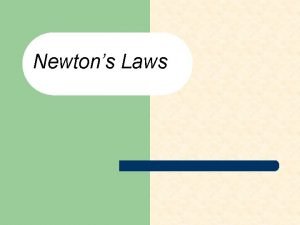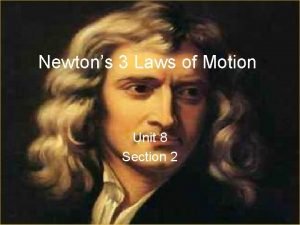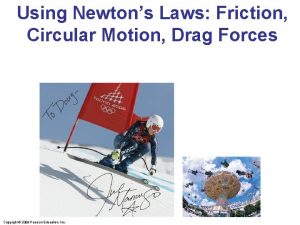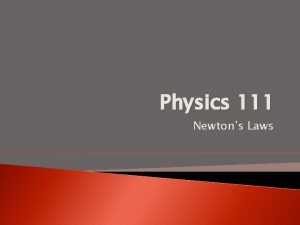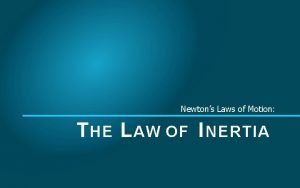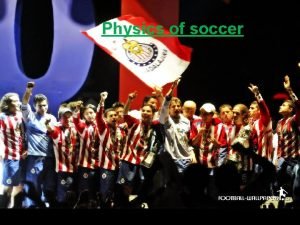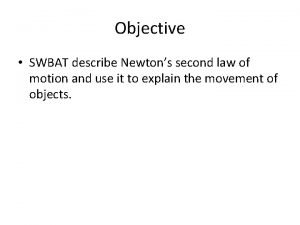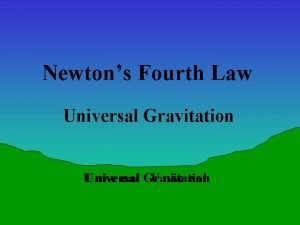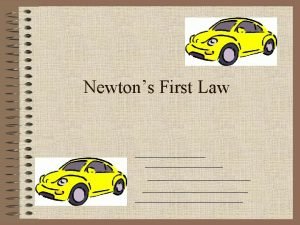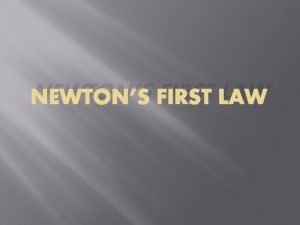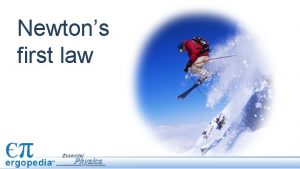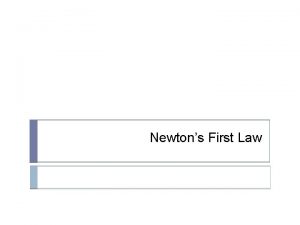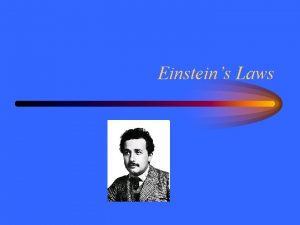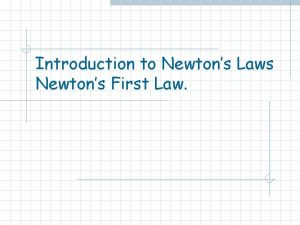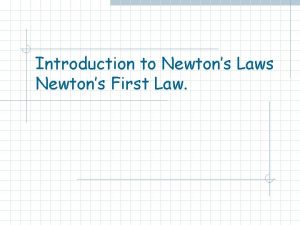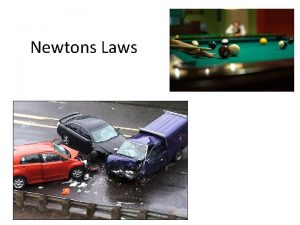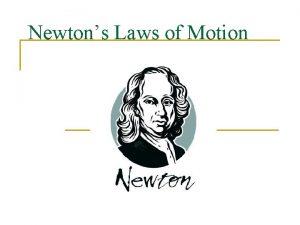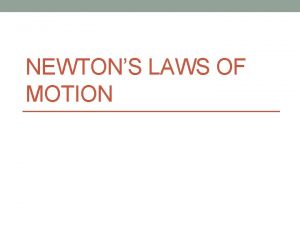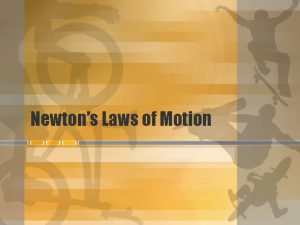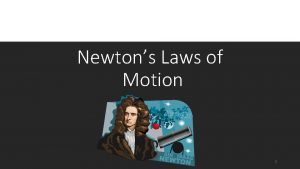Newtons Laws Newtons First Law The law of


































- Slides: 34

Newton’s Laws

Newton’s First Law The law of Inertia

Newton’s First Law ¡ ¡ Newton's first law of motion is often stated as: “An object at rest remains at rest and an object in motion will continue to move in straight-line motion with the same speed and in the same direction unless acted upon by an unbalanced force. ” There are two parts to this statement l l One which predicts the behavior of stationary objects The other which predicts the behavior of moving objects.

Newton’s First Law Forces are Balanced Objects at Rest (v=0 m/s) a = 0 m/s 2 Stay at rest Objects in Motion (v≠ 0 m/s) a = 0 m/s 2 Stay in Motion

Newton’s First Law ¡ ¡ ¡ The behavior of all objects can be described by saying that objects tend to "keep doing what they're doing" (unless acted upon by an unbalanced force). If at rest, they stay in rest. If in motion with an eastward velocity of 5 m/s, they will continue in this same state of motion (5 m/s, East). If in motion with a leftward velocity of 2 m/s, they will continue in this same state of motion (2 m/s, left). Inertia - The state of motion of an object is maintained as long as the object is not acted upon by an unbalanced force. All objects resist changes in their state of motion - they tend to "keep on doing what they're doing. "

Example ¡ ¡ Suppose that you filled a pail to the rim with water and walked around an oval track making an attempt to complete a lap in the least amount of time. What would happen? The water would have a tendency to spill from the pail during specific locations on the track. In general the water would spill when: l l l the pail is at rest and you attempt to move it the pail is in motion and you attempt to stop it the pail is moving in one direction and you attempt to change its direction.

Example (cont. ) ¡ ¡ ¡ We find that the water spills whenever the state of motion of the container is changed. The water resisted this change in its own state of motion (kept doing what it was doing). The container was moved from rest to a high speed at the starting line; the water remained at rest and spilled onto the table. The container was stopped near the finish line; the water kept moving and spilled over container's leading edge. The container was forced to move in a different direction to make it around a curve; the water kept moving in the same direction and spilled over its edge. The behavior of the water during the lap around the track can be explained by Newton's first law of motion.

Newton’s First Law in Everyday Life Have you ever observed the behavior of coffee in a coffee cup filled to the rim while starting a car from rest or while bringing a car to rest from a state of motion? ¡ What happens? ¡

Coffee Example ¡ When you accelerate a car from rest, the road provides an unbalanced force on the spinning wheels to push the car forward; yet the coffee (which was at rest) wants to stay at rest. While the car accelerates forward, the coffee remains in the same position; subsequently, the car accelerates out from under the coffee and the coffee spills

Newton’s First Law in Everyday Life – Why you should buckle up! ¡ Have you ever experienced inertia (resisting changes in your state of motion) in an automobile while it is braking to a stop? l l l ¡ The force of the road on the locked wheels provides the unbalanced force to change the car's state of motion, yet there is no unbalanced force to change your own state of motion. Thus, you continue in motion, sliding along the seat in forward motion. A person in motion tends to stay in motion with the same speed and in the same direction. . . unless acted upon by the unbalanced force of a seat belt. Seat belts are used to provide safety for passengers whose motion is governed by Newton's laws. The seat belt provides the unbalanced force which brings you from a state of motion to a state of rest. Perhaps you could speculate what would occur when no seat belt is used…

EXTRA CREDIT OPPORTUNITY!! ¡ ¡ Get a metal coat hanger that you are allowed to destroy. Pull the coat hanger apart. Using duct tape, attach two tennis balls to opposite ends of the coat hanger as shown in the diagram at the right. Bend the hanger so that there is a flat part which balances on the head of a person. The ends of the hanger with the tennis balls should hang low (below the balancing point). Place the hanger on your head and balance it. Then quickly spin in a circle. What do the tennis balls do? Bring it in with a one paragraph description of what happens, demonstrate it for the class, and earn up to 10 bonus points! Due Tuesday (11/9). You too can look this cool!

Newton’s Second Law of Motion

Newton’s Second Law of Motion ¡ ¡ Newton's second law of motion pertains to the behavior of objects for which all existing forces are not balanced. The second law states that the acceleration of an object is dependent upon two variables - the net force acting upon the object and the mass of the object. l l As the force acting upon an object is increased, the acceleration of the object is increased. As the mass of an object is increased, the acceleration of the object is decreased.

Newton’s Second Law Forces are Unbalanced There is an acceleration The acceleration depends directly on the net force The acceleration depends inversely upon the object’s mass

Newton’s Second Law of Motion ¡ ¡ ¡ “The acceleration of an object as produced by a net force is directly proportional to the magnitude of the net force, in the same direction as the net force, and inversely proportional to the mass of the object. ” a = Fnet/m or Fnet = ma Note: Newton’s Second Law deals only with the NET FORCE

Practice Problems – Set 1 1. 2. 3. 4. 5. If Fnet = 10 N and the mass is 2 kg, what is a? If Fnet = 20 N and the mass is 4 kg, what is a? If the mass is 2 kg and a is 5 m/s 2, what is Fnet? If a is 10 m/s 2 and Fnet is 10 N, what is the mass?

Answers – Set 1 1. 2. 3. 4. 5. 5 m/s 2 10 m/s 2 5 m/s 2 10 N 1 kg

The Force-Mass-Acceleration Relationship From the previous problems, we saw that acceleration is directly proportional to net force (the direction of the net force is in the same direction as the acceleration) ¡ We also saw that acceleration is inversely proportional to mass. ¡

Practice Problems – Set 2 Look at the oil drops left by the car in a and b. Which way is the acceleration vector pointing in both? a. b.

Answers – Set 2 a. b. To the right. To the left.

Conclusion ¡ ¡ Newton's second law provides the explanation for the behavior of objects upon which the forces do not balance. The law states that unbalanced forces cause objects to accelerate with an acceleration which is directly proportional to the net force and inversely proportional to the mass.

Newton’s Third Law and Interaction (action-reaction) Forces

Newton's Third Law ¡ ¡ According to Newton, whenever objects A and B interact with each other, they exert forces upon each other. Ex: when you sit in your chair, your body exerts a downward force on the chair and the chair exerts an upward force on your body. There are two forces resulting from this interaction - a force on the chair and a force on your body.

Newton’s Third Law These two forces are called action and reaction forces and are the subject of Newton's third law of motion. Formally stated, Newton's third law is: “For every action, there is an equal and opposite reaction. ” ¡

Newton’s Third Law ¡ The statement means that in every interaction, there is a pair of forces acting on the two interacting objects. l l ¡ The size of the forces on the first object equals the size of the force on the second object. The direction of the force on the first object is opposite to the direction of the force on the second object. Forces always come in pairs - equal and opposite action-reaction force pairs.

Newton’s Third Law ¡ Work with your aisle partner to draw the forces on the following situations: 1. 2. 3. A fish swimming in water A bird flying through the air Your car on the way to school

Explanation 1 ¡ A fish uses its fins to push water backwards. Since forces result from mutual interactions, the water must also be pushing the fish forwards, propelling the fish through the water. The size of the force on the water equals the size of the force on the fish; the direction of the force on the water (backwards) is opposite the direction of the force on the fish (forwards).

Explanation 2 ¡ A bird flies by use of its wings. The wings of a bird push air downwards. Since forces result from mutual interactions, the air must also be pushing the bird upwards. The size of the force on the air equals the size of the force on the bird; the direction of the force on the air (downwards) is opposite the direction of the force on the bird (upwards).

Explanation 3 ¡ Consider the motion of a car on the way to school. A car is equipped with wheels which spin backwards. As the wheels spin backwards, they grip the road and push the road backwards. Since forces result from mutual interactions, the road must also be pushing the wheels forward. The size of the force on the road equals the size of the force on the wheels (or car); the direction of the force on the road (backwards) is opposite the direction of the force on the wheels (forwards).

Interaction Forces (Action-Reaction Forces) ¡ ¡ ¡ According to Newton's third law, for every action force there is an equal (in size) and opposite (in direction) reaction force. Forces always come in pairs - known as "action-reaction force pairs. " Identifying and describing action-reaction force pairs is a simple matter of identifying the two interacting objects and making two statements describing who is pushing on whom and in what direction. For example, consider the interaction between a baseball bat and a baseball.


Baseball!!! ¡ ¡ ¡ The baseball forces the bat to the right; the bat forces the ball to the left. Together, these two forces exerted upon two different objects form the actionreaction force pair. Note that in the description of the two forces, the nouns in the sentence describing the forces simply switch places.

Consider the following… ¡ One of the forces in the mutual interaction is described; describe the other force in the actionreaction force pair. l l l Baseball pushes glove leftwards. Bowling ball pushes pin leftwards. Enclosed air particles push balloon wall outwards.

Answers The glove pushes the baseball rightward. ¡ Pin pushes bowling ball rightward. ¡ Balloon wall pushes enclosed air particles inwards. ¡
 What is the relationship between inertia and mass
What is the relationship between inertia and mass Newton's 1st law meme
Newton's 1st law meme First law of newton
First law of newton Newton's law
Newton's law Newtons first law pictures
Newtons first law pictures 6 67 x 10^-11
6 67 x 10^-11 What are newtons 3 laws
What are newtons 3 laws Third law of newton
Third law of newton Section 3 using newton's laws
Section 3 using newton's laws Section 1 forces
Section 1 forces Elevator bank
Elevator bank Newtons laws od motion
Newtons laws od motion Newtons 1 st law
Newtons 1 st law What are newtons 3 laws
What are newtons 3 laws Newtons law quiz
Newtons law quiz Newton's 3rd law example
Newton's 3rd law example Newtons three law
Newtons three law Newton law
Newton law Law of newton 3
Law of newton 3 Newton's law
Newton's law Newton's laws
Newton's laws All 3 newtons laws
All 3 newtons laws When the pellet fired into the spiral tube
When the pellet fired into the spiral tube Newton's laws 3
Newton's laws 3 Newton's laws of motion
Newton's laws of motion Newton's second law of circular motion
Newton's second law of circular motion Newtons laws
Newtons laws Newton's first law and second law and third law
Newton's first law and second law and third law Newton's first law of motion
Newton's first law of motion Facts about montesquieu
Facts about montesquieu Newtons first ;aw
Newtons first ;aw Newtons 3 rd law of motion
Newtons 3 rd law of motion Physics
Physics Describe newtons second law
Describe newtons second law What is newton's fourth law
What is newton's fourth law

